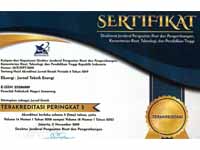KARAKTERISTIK TURBIN ULIR PADA ALIRAN AIR SUNGAI YANG MEMILIKI HEAD RENDAH SEBAGAI PEMBANGKIT TENAGA LISTRIK
DOI:
https://doi.org/10.32497/eksergi.v17i3.2983Keywords:
Efisiensi, Energi Listrik, Pembangkit listrik, Turbin UlirAbstract
Turbin Ulir yang ada pada aliran air yang memiliki head Rendah Sebagai Pembangkit tenaga listrik ini bertujuan untuk menghasilkan energy listrik yang memanfaatkan potensi sumber daya air pada aliran air dengan head rendah.
Kontruksi turbin ulir memiliki sudu berdiameter 360 mm, 1 sudu-sudu, 8 daun sudu dengan panjang 1m dan memiliki diameter poros 80mm. yang dilengkapi dengan system transmisi untuk membangkitkan listrik. Pengujian dilakukan dengan variasi beban lampu disaat debit air dan kecepatan aliran air bernilai konstan. Parameter yang diukur dalam pengujian adalah debit air, putaran turbin (rpm), putaran generator (rpm), arus listrik (A), tegangan generator (V). Hasil dari pengujian turbin ulir ini didapatkan nilai efisiensi tertinggi pada debit 0,0462 , kecepatan aliran air 0,956, pada putaran turbin 169,3rpm dan daya listrik 3,2watt yaitu 15,19%.
References
Harjo, Herman Budi. dkk. 2014. Penentuan Dimensi Sudu Turbin dan Sudut
Kemiringan Poros Turbin pada Turbin Ulir Archimedes. Bandung: Politeknik
Manufaktur Negeri Bandung. Vol. 36, No. 1.
https://arifsh2009.wordpress.com/2014/11/02/generator-dan-motor-dc/diakses tanggal
Agustus 2021.
Juliana, I Putu, Antonius Ibi Weking dan Lie Jasa. 2018. “Pengaruh Sudu Kemiringan
Turbin Ulir dan Daya Putar Turbin Ulir dan Daya Output pada Pembangkit Listrik
Tenaga Mikrohidro” dalam Majalah Ilmiah Teknologi Elektro, Vol. 17 No. 3,
September-Desember 2018.
Rorres, C., 2000. The Return of The Screw: Optimal Design of an Archimedes, Journal
of Hydraulic Engineering, 126 (1), 72-80.
Downloads
Published
Issue
Section
License
Authors who publish with this journal agree to the following terms:Authors retain copyright and grant the journal right of first publication with the work simultaneously licensed under a Creative Commons Attribution License that allows others to share the work with an acknowledgement of the work's authorship and initial publication in this journal.
Authors are able to enter into separate, additional contractual arrangements for the non-exclusive distribution of the journal's published version of the work (e.g., post it to an institutional repository or publish it in a book), with an acknowledgement of its initial publication in this journal.
Authors are permitted and encouraged to post their work online (e.g., in institutional repositories or on their website) prior to and during the submission process, as it can lead to productive exchanges, as well as earlier and greater citation of published work (See The Effect of Open Access).






